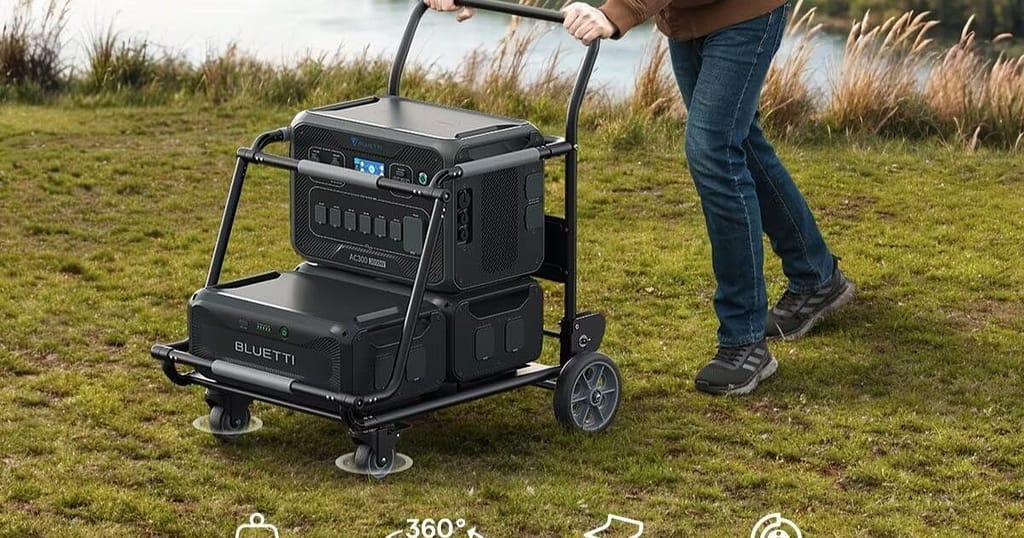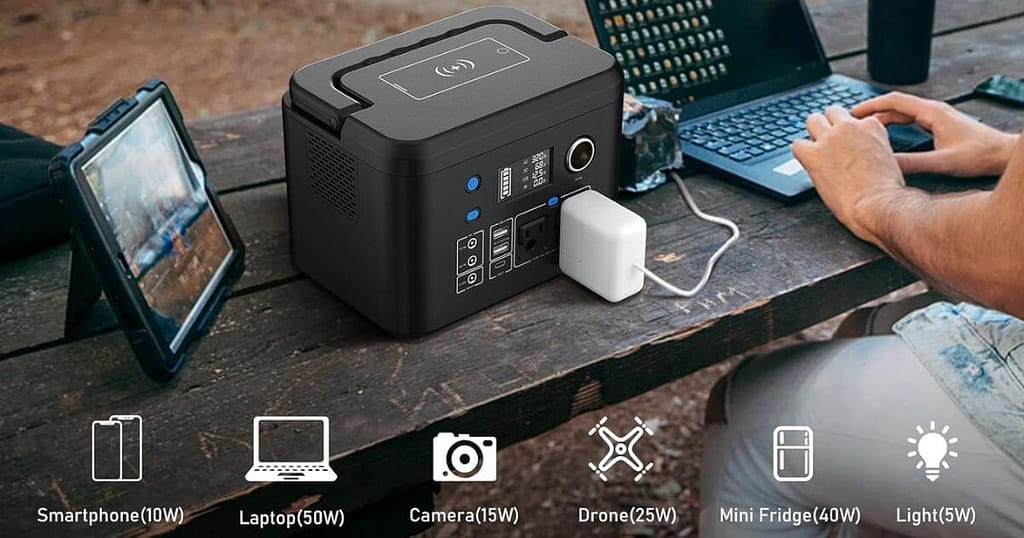
In this article, I’m going to show you each feature of Jackery Explorer 240. You’ll be informed about each advantage or disadvantage of this model so that you can make your own decision whether it is suitable for you or not. If It’s not good for you then I’ll tell you the other options which will be perfect for you.
A Quick Overview
When it comes to having reliable power on your adventures, the Jackery Explorer 240 really delivers. Whether you’re camping, tailgating or just need backup for power outages at home, this little powerhouse has you covered.
Some of the things that make it so useful are the built-in protections like surge protection and short circuit prevention. That means you can feel safe charging all your gadgets without worrying about frying anything. It also has temperature control to keep running smoothly no matter the conditions.
Another awesome feature is the pure sine wave output. This is important because it allows you to run more sensitive devices and appliances just like on regular power. No need to worry about flickering lights or your blender not working correctly in the great outdoors.
Charging it is a breeze – simply plug it in at home until the battery indicator shows full. From there you’ve got portable power for whatever you need while away from an outlet. And the digital display is super handy for checking exactly how much juice is going in and out in watts.
Versatility is key and this Jackery solar generator delivers with its variety of charging ports. Dual USB outputs let you fuel multiple devices simultaneously. The AC outlet gives you flexibility for larger appliances too. Individual on/off switches make managing everything simple.
Whether you need backup power for emergencies or just want reliable juice for camping trips, the Jackery Explorer 240 has you covered in a very portable and affordable package. It’s definitely one of the best power station investments for all your outdoor adventures!
What You’ll like in this model?
Overall look and Design

The Jackery Explorer 240 is about the size of a small cooler – not too big, not too small. Measuring around 9 inches long, 5 inches wide, and 8 inches tall, it’s compact enough to easily fit in a backpack or small suitcase. At just under 7 pounds, it’s also very lightweight. I can comfortably carry it with one hand for short distances.
While it may seem heavy for a kid, my 8-year-old daughter has no problem lifting it. The durable plastic exterior feels sturdy and protective. I don’t worry about her accidentally dropping it like she does with her phone! We’ve tested its durability too – it’s taken a few tumbles out of the car and once fell out of the hammock under my wheelchair. Yet it still works perfectly without any visible damage.
The compact size and lightweight design make it very portable. I like being able to bring it with me places without adding much extra bulk or weight to my bag. Whether I’m working outside, camping, or just need some extra battery life on a long travel day, the Jackery portable power station reliably powers my devices without weighing me down. Its tough construction also gives me peace of mind, knowing it can withstand the occasional bump or drop from kids or pets without issue.
In short, while it may not be truly “lunchbox sized,” the Jackery Explorer 240 packs a lot of portable power into a small, durable and easy-to-carry package. Its compact dimensions and lightweight build make it a great companion for on-the-go device charging without compromising on functionality or durability.
LED Display
One really handy feature of the Jackery Explorer 240 is their little screen that gives you all the important info at a glance. It shows you how much juice is flowing in through the solar panel or car charger in watts. Really cool to see it climbing as the sun does its thing!
It also shows how many watts your gadgets are draining as you use them. Come to think of it, I never really knew my phone pulled like 15 watts until I saw it on the display. Kind of makes you appreciate just how much power these little devices suck down.
But most importantly, the screen constantly updates you on how full the battery is. No more guessing if you’ll have enough juice to finish your Netflix binge outside or make it through campfire s’mores without your phone dying. A quick look and you know exactly where you stand.
Honestly, having the input, output and charge level right there is super reassuring. No more math equations trying to calculate if you packed enough power. The Jackery takes all the guesswork out of staying charged on the go. The display is simple to read but really packs a ton of useful charging info into a tiny space. It’s the kind of small feature that makes a big difference, especially for us gadget addicts always on the hunt for more battery life!
Outlets
The ports on this Jackery Explorer 240 are seriously impressive. It’s got the basics covered – a standard AC outlet so you can plug in anything you use around the house. Perfect for keeping devices juiced up while camping or if the power goes out.
It also includes a car port so you’ve got options to charge in the vehicle. Great for long road trips or if you need power while off-roading. Just plug it in and let it fill up the battery as you drive.
Where the Jackery 240 generator really shines though are the USB ports. It’s got two of them so you can fast charge multiple devices simultaneously. Whether it’s your phone, headphones, Switch or Kindle – these ports pump out plenty of Watts to refuel it all. No more swapping cables back and forth.
Besides that, in addition to USB, it’s also got a full AC outlet that puts out a pure sine wave. This means you’ve got the flexibility to charge anything that plugs into the wall, from laptops to DSLRs. Pretty incredible all that power fits in such a compact size, right?
Another handy feature is the individual power buttons for each port. No more accidentally draining the whole battery if you forget to turn one off. Just press and it cuts the juice. Makes managing everything a breeze.
Overall, the Jackery Explorer 240 is an absolute workhorse. It covers all your charging needs from big to small appliances, no matter where life’s adventures take you. And having all those options in a package this compact is pretty impressive if you ask me. Definitely gives you way more flexibility than some puny battery pack!
Battery & Performance

Now I know 240 watt hours doesn’t sound like much compared to big ol’ car batteries. But hear me out – this thing packs some serious power into a tiny package thanks to Jackery Explorer 240’s lithium-ion cells.
See, unlike other batteries, you can drain a lithium one all the way down without hurting it. So you get every last drop of juice out of those 240 watt hours. To put it in perspective, that’s enough to fully charge my iPhone over 25 times.
It’ll also give my Mavic Mini drone almost 15 flights before needing a recharge. Not bad considering how long the battery on those things usually lasts. And you could get close to 5 charges out of my Macbook Air if I really needed to in a pinch.
Heck, you could even run some bigger items for a decent amount of time. The Explorer can power a standard 42-inch TV for about 2.5 hours of streaming. Or keep a mini fridge chugging for close to 20 hours, which is perfect for camping trips.
So while that 240 watt hour rating may seem small at first, lithium-ion packs a serious punch. It delivers power efficiently over and over without degrading. Pretty awesome what you can get out of such a tiny package if you ask me!
Recharging

Refilling the battery of the Jackery Explorer 240 is quite simple. There are three main ways to juice it back up, giving you flexibility no matter your power situation.
The first is using the included AC adapter. This charger plugs into any regular wall outlet to draw power from your home electricity. It’s rated at 19V, 3.42A 65 watts, which is more than enough to charge the Explorer at a good pace. From my testing, it takes right around 5-6 hours to go from empty to completely full using this method. It’s by far the fastest way to recharge.
Next you’ve got the car charger cable. This allows you to tap into your vehicle’s 12V power outlet for on-the-go charging. Simply plug it in and the Explorer will slowly sip the electricity as you drive. This method takes a bit longer at around 6-7 hours for a zero to 100% charge. But it’s great for refueling while traveling between destinations.
The third option is to use an optional solar panel, like Jackery’s 60W model. Any panel with the correct 8mm tip will work though. The panel’s built-in MPPT controller efficiently transfers the solar energy into charging the battery. A full charge takes approximately the same amount of time as from the car – around 6-7 hours depending on sunlight. It’s a more eco-friendly way to power up.
No matter which charging method you choose, the Explorer supports pass-through charging as well. So you can actually use it to power devices simultaneously while it’s refilling. Handy if you need backup power but still want to charge gadgets at the same time.
What are the bad things of Jackery Explorer 240?
Less of USB type-C port and Fast charging
The one downside I’ve found with the Jackery Explorer 240 is that its USB ports are a bit outdated. It only has the standard USB-A ports, which are great for older phones and devices. But if you’ve got any of the newer gear with USB-C, you’ll be out of luck.
Not having a USB-C PD port that can fast charge laptops and high-powered devices is a bummer. Those new Macbooks, Chromebooks, cameras and drones really suck down the Watts when they’re low on juice. It’d be nice to be able to quickly top them off from the Explorer.
The USB-A ports also don’t support the Quick Charge standards, so you won’t get accelerated charging on newer Android phones either. Going from 0-100% in an hour would be awesome while camping or off the grid.
Luckily there is a workaround – Jackery includes a car charger cable that you can leave plugged into one of the ports instead. As long as your phone supports Quick Charge 3.0, it’ll take advantage of those faster speeds.
Not waterproof
While the Jackery Explorer 240 isn’t fully waterproof, Jackery does say the internal components are protected against splashes and light rain. So short-term exposure to some moisture is generally okay and shouldn’t cause any issues. For prolonged rainy conditions though, using it under an awning, canopy or in your vehicle would help prevent any possibility of moisture getting inside over extended periods of time outdoors in the wet weather. Proper storage when not in use is also important to avoid any water exposure when not needed.
Most portable power stations at this price point tend to forgo full waterproofing in their designs in order to keep costs down for customers. It’s usually a feature found on higher-end or specialty models that are designed and priced for more marine or rugged outdoor use cases. An accidental dunking in a puddle or something likely wouldn’t destroy the Explorer, but water getting inside could potentially cause problems over time if not dried out properly.
For many outdoor use cases on rainy days where you need power, setting up the Explorer under some type of cover and using extension cables to connect devices may still allow it to function adequately without issue. As long as basic precautions are taken in wet weather to avoid prolonged exposure, the risk of moisture problems doesn’t seem too high.
So while full water resistance would be ideal, the lack of it isn’t necessarily a dealbreaker in my view. There are workarounds that can be used on rainy days, and most casual outdoor use shouldn’t have moisture issues if cared for properly. The tradeoff is you get a very affordable and capable power station for various applications. But waterproofing would be a nice addition, no doubt about it.
I want to make this information more user-friendly and share advantages of this detail that should be relevant and real human writing tone, also easy to understand:
Final Verdict
The Jackery Explorer 240 is a perfect portable power station for powering your small size important tools and appliances at anywhere.
Having a sturdy plastic body and a user-friendly handle make it more comfortable for long distances. It has an ideal-size battery that makes it perfect for camping and RV trips.
Also, a user-friendly LED display makes it easy to use, since it’ll alert you all about this power bank.
This solar generator can be used while charging. Unfortunately, it doesn’t come with USB type-c port, and it doesn’t support fast charging. Another thing is you’ll have to care it while using it on rainy days at camping trips because it isn’t waterproof.
Overall this one is still the best in the market and many users like it. If you want to go to other options then you must try the Anker 521 portable power station or Ecoflow River 2.
Also, we recommend you check our comparisons of Jackery explorer 240 vs Anker 521 or Jackery 240 vs Ecoflow River 2 for more clarity in your mind.
Recommended Portable Power Stations:




